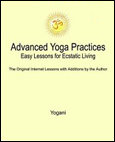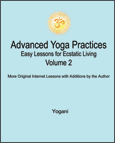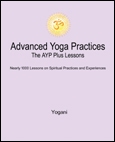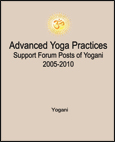|
Public Home | Plus Home | Main Lessons | Tantra Lessons | Public Forum | Plus Forum | Downloads | Books Topic Paths | Search | Training-Retreats | Testimonials | Survey | Interviews | MultiMedia | Contact | Donate |
|
Advanced Yoga Practices Note: For the Original Internet Lessons with additions, see the AYP Easy Lessons Books. For the Expanded and Interactive Internet Lessons, AYP Online Books, Audiobooks and more, see AYP Plus. Lesson 253 - A Book List and a Brief History of the Rise of Yoga in the West (Audio)
AYP Plus Additions:
From: Yogani New Visitors: It is recommended you read from the beginning of the archive, as previous lessons are prerequisite to this one. The first lesson is, "Why This Discussion?"
It gets back to what we have been experiencing and discussing all along in the AYP lessons. Just a little purification and opening in our nervous system releases a stream of divine light from within us. As soon as this happens, we begin to feel the connectedness of yoga. Suddenly, we become more aware. If we have been meditating, we find more desire to read scriptures and spiritual books. We want to know more. Then we want to take on more practices: spinal breathing pranayama, asanas, mudras, bandhas, samyama, and so on. The rise of the desire to study is found in the second limb of yoga, the niyamas. You will recall from lesson #149 that we rely mainly on meditation, pranayama and other practices near the root of the eight-limbed tree of yoga to stimulate the yamas (restraints) and niyamas (observances). These are the codes of conduct that we find in all religions. Spiritual study is "svadhyaya," one of the five niyamas. Spiritual study is actually study of the Self, our divine Self, which is the real meaning of the word svadhyaya. The higher we go in purification and opening of our nervous system, the more we see scriptures as an extension of the knowledge bubbling up within us. We identify with spiritual writings more and more because they are a mirror to us. In the end, we don't need any books at all. We become "the book," and then we are reading the divine knowledge of our divine Self directly all the time, within and all around us. Until we reach that stage, books made of paper (and digital, these days) come in very handy. So thank goodness the great sages and teachers over the centuries took the time to write down their experiences and methods. Over the past few weeks I have gone through the library here and made a book list. It ended up being nearly 500 titles. So now you know where I have been lately - up to my third eye in sacred books! You can find the book list at: http://www.aypsite.org/booklist.html. The book list can also be reached from the AYP Links Section. As it says in the introduction to the book list, this is not a recommended reading list. Reading 500 books is not a prerequisite for enlightenment. With direct teachings, inspired daily practice, and some good common sense, it can be done with very few books. But we all have different needs and appetites for reading, so it was decided to create a broad list that has something on it for just about everyone. It is a resource similar to the AYP links section, which also has a lot of spiritual literature on it. The book list is a place you can go and browse for inspiring and useful information relating to your chosen path. Links are provided on the book list to Amazon.com and other locations on the Internet where you can find further information on specific titles listed, and on related ones. So, the book list, with its many links, is a spiritual library of sorts - a broad resource. The list itself is not all-inclusive, and is not intended to be. It is only a few drops in the bucket of the total of spiritual literature out there. If you use the book list links, you can find hundreds more titles. The AYP book list can be a starting point for new discoveries in spiritual reading, if that is what you are being called to on your path. And if you are not, then just keep up your daily practices. As mentioned, ultimately, you are "the book." Yoga in the West There is another benefit to be found in the book list. Because it is a record of English translations and writings on Eastern philosophy and spiritual methods, it draws a sketch for us of how yoga has risen in the West over the past 150 years, or so. It is fascinating how it happened. This history was touched on back in lesson #93, "Changing Times." Now let's fill in more details, using the book list as a reference. Back in the mid-1800s, India was under colonial rule by the British Empire. This is where the migration of yoga westward began. English translations of the Bhagavad Gita, a few key Upanishads and other scriptures found their way into the hands of Western thinkers such as Ralph Waldo Emerson, Henry David Thoreau, and others. While yoga practices were not part of that transmission, these intellectuals were deeply affected philosophically. The Eastern writings played a key role in the rise of "Transcendentalism" in New England during that time. It became clear to them that there was something beyond the reach of the senses that was the source of our external world. The Transcendentalists resolved to live from that level of "the oversoul," as Emerson called it. He was talking about pure bliss consciousness, the animator of all existence. From their point of view, the call was for a simpler, more ethical life, lived closer to nature, and this is reflected in the inspired writings of that period. Around 1875, a group was formed in New York City called the "Theosophical Society," devoted to unraveling the mysteries of the occult. Back in those days, the word "occult" meant simply what could not be seen with the outer senses. Seances and the supernatural were all the rage in those days, and Theosophy capitalized on that popular interest and took it far beyond. Founded by Helena Blavatsky and William Judge, and carried forward by Annie Besant after the turn of the century, the Theosophical Society took the lead in opening up the doorway to Eastern philosophy. They excelled in providing glimpses of the inner life, inner worlds, the evolution of consciousness, and the divine possibilities of humanity through the writings of Blavatsky, Judge, Besant, Charles Leadbeater, Arthur Powelland others. You will see these on the book list under the Theosophy category. More importantly, the Theosophical Society soon set up its headquarters near Madras, India and established contacts with advanced yogis who advised them through direct meetings and letters. So, the Theosophical Society became a pipeline of yogic knowledge to the West early on, mainly through its writings, and has continued in that role through the publication of hundreds of books since the late 1800s. Many of these books are direct translations of Indian scriptures. Even so, the Theosophical Society has rarely ventured beyond the purely philosophical, and never did lead an effective expansion of Western awareness from philosophy/theory to direct participation in the processes of human spiritual transformation through organized systems of yoga practice. This was done by others. The Theosophical Society was also responsible for finding and attempting to elevate J. Krishnamurti to the status of a "world teacher," though eventually he refused both the sponsorship and title, going on to lecture and write from a base in the USA from the 1920s until his death in the 1980s. His books are numerous, with most being compiled from his lectures. His denial of guruship included a denial of all structured practice, which led to him sometimes being labeled as the "do nothing" guru (see Lesson 84). Nevertheless, his influence in the West has been huge. He could be regarded to be the first non-duality (advaita-vedanta) teacher to come to the West, though he no doubt would have denied that distinction also. In the meantime, advanced yogis in India were connecting with their British occupiers in the late 1800s and early 1900s. Most notable among them was a colonial magistrate, Sir John Woodroffe, who became deeply involved in the then obscure cult of tantra, and wrote about a dozen books on its philosophy and practices under the pen-name, "Arthur Avalon." Woodroffe's books are so lucid and thorough that they have inspired a revival of tantra in India. His crowning achievement was "The Serpent Power" in 1919, which, more than any other English language book from that era, details the methods of yoga, tantra and kundalini awakening. It is still a useful resource for yogis and yoginis today, both East and West. While some good initial writings were appearing both before and after the dawn of the 20th century, yoga needed real yogis coming to the West in order to take firm root. And so they came... Ramakrishna was one of the greatest sages of late 1800s India. He demonstrated how a human being can achieve enlightenment by both Eastern and Western methods. He is said to be one of the greatest bhakti yogis ever. From his intense devotion to the divine, all the rest of yoga sprung out of him like a fountain. Several years after Ramakrishna's death in 1886, his leading disciple, Swami Vivekananda, came to the World Parliament of Religions in Chicago in 1893. He was an instant sensation, and spent the next seven years traveling and speaking throughout the USA and Europe. As a result of Vivekananda's work, a worldwide organization sprung up called the "Vedanta Society," and one called the "Ramakrishna Order" in India. But Vivekananda did not live to see the growth of these. He passed on in 1902. Decades later, his essays and lectures were published in a series of popular books on the main branches of yoga - karma, bhakti, jnana andraja. These can be found on the book list. Besides being a worldwide religious organization with facilities and practitioners, the Vedanta Society has also served a similar role as the Theosophical Society in publishing Eastern literature. It has done so with more authority, being founded by disciples of Ramakrishna and Vivekananada. Some famous books from Vedanta include the writings of Swami Prabhavananda and Christopher Isherwood in the 1940s and 1950s on the Bhagavad Gita, Upanishads,Shankara, Patanjali's Yoga Sutras, Jesus and others. But, like the Theosophical Society, the Vedanta Society has done little to bring actual yoga practices to the average Westerner. This fell to others who were willing to part the veil of secrecy that has surrounded the knowledge of yoga practices for centuries. Sir John Woodroffe did a lot to help open things up with his "Serpent Power" in 1919. There was some writing on direct yoga practices in the West even before that. In the first decade of the 20th century, a series of books were published under the name "Yogi Ramacharaka." This was a collaboration between an American, William Atkinson, and Baba Bharata, a yogi who also spoke at the World Parliament of Religions in Chicago in 1893. The background on Baba Bharata is fuzzy. It is believed he was a disciple of an Indian Yogi Ramacharaka who lived in South Africa. At any rate, the books were written and contain more detail on yoga practices than had been seen in the West before (Vivekananda's books were not published until decades later). Ramacharaka's book called "Science of Breath" is especially significant. It is a good primer on pranayama, even by today's standards. His "Fourteen Lessons in Yoga Philosophy," "Advance Course in Yoga Philosophy" and other books, are equally inspiring. So, around 1900 we had two yogis making a significant impact in America, and Vivekananda went to Europe also. In Europe, Eastern wisdom had an influence on the unique intellect-based styles of several noted European spiritual teachers of the early 20th century, including Rudolf Steiner (a former Theosophist), GI Gurdjieff and PD Ouspensky. Later on, the Indian-style yoga systems would come to Europe from both the USA and India. In 1920 the West welcomed its first long-term yoga master in the form of Paramahansa Yogananda, of the Kriya Yoga lineage. He resided in Los Angeles for over 30 years until his death in 1952. He traveled extensively throughout the USA and Europe, initiating disciples everywhere in the methods of Kriya Yoga. Yogananda was a powerful spiritual personality and profoundly influenced the thousands he met. Through his popular book, "Autobiography of a Yogi," published in 1946, he has continued to open the lives of millions to the realms of their inner spirit. In 1958 the West saw the arrival of another great yogi when Maharishi Mahesh Yogi landed in Los Angeles. Ten years later, after the Beatles and other Western celebrities had joined him, the Maharishi's teaching of Transcendental Meditation became a worldwide phenomenon. The Maharishi has been responsible for millions finding their way to inner silence on a daily basis. He has founded teaching centers, universities, and numerous other organizations and institutions worldwide, all based on the simplicity and power of pure bliss consciousness, the silent source within us all. In the 1980s, the Maharishi launched Ayurveda (the yoga-based Indian system of medicine) in the West, which has had a huge impact on millions more. Deepak Chopra and others who are working to bring Ayurveda and yogic methods into the mainstream of Western society found their beginnings with the Maharishi. His landmark book, "The Science of Being and Art of Living," published in 1963, is a classic. Thanks largely to the work of "the big three" who came directly from India to teach, Vivekananda, Yogananda and the Maharishi, the West has experienced a virtual explosion of yoga since the 1960s. Certainly there were other teachers and threads of yogic knowledge before then, and hundreds have appeared since the 1960s as more and more Indian yogis and teachers have written books in English and/or come to the West. It is not possible to cover them all in this brief history. However, we should mention a few who, through their activities and/or writings, have played important roles in helping make the knowledge of yoga methods more open to aspiring westernpractitioners: Pierre Bernard - A flamboyant American hatha yogi and tantrika who operated a popular ashram near New York City in the 1920s and 1930s, attracting many of the rich and famous people of the day. Dubbed "The Great OOM" by the media, his early influence continues to be felt in westernized hatha and tantra teachings. He was the student of a little known Indian yogi, Sylvais Hamati, and his story has been documented in a 2010 book, "The Great OOM: The Improbable Birth of Yoga in America." Swami Satyananda - A leading disciple of the great Swami Sivananda of India, and founder of the Bihar School of Yoga. His books are among the most revealing on practices in yoga, tantra, kriya and kundalini. His most famous one is "Kundalini Tantra," published in 1984. Swami Rama - A former Shankaracharya (a high religious post in India), and something of a misfit, he came to the USA in 1971 and demonstrated "super-normal" abilities under scientific conditions. He then founded the Himalayan Institute in Pennsylvania, taught many students, and wrote some of the best books on yoga anyone has ever seen, making a huge contribution to the literature. His great books are too many to name - see the book list for some of them. A couple of favorites are his spiritual autobiography, "Living with the Himalayan Masters," and his new classic on kundalini/tantra yoga, "Path of Fire and Light." Ramana Maharshi and Nisargadatta Maharaj - Two Advaita-Vedanta giants of the 20th century, not associated with each other. While not traveling from India, these two have had a major influence on western thinking, and the practice of "self-inquiry" on the non-dual nature of existence. Ramana was "discovered" in the early part of the century by British journalist, Paul Brunton, and introduced to the West in his famous book, "A Search in Secret India." Many of Ramana Maharshis talks are available in book form. Nisargadatta became prominent in the late 20th century, popularized in the West by baby-boomers who sat at his feet in India, and by his large book on Advaita and self-inquiry, "I Am That." BKS Iyengar - Perhaps the greatest (and certainly the most tireless) hatha yogi of the 20th century. His 1965 book "Light on Yoga" is still a leading textbook for hatha yoga practitioners around the globe. Swami Sivananda - This physician turned yogi was one of the most prolific writers on yoga ever, having written several hundred books. Unfortunately only a few are available in the West. See some of them on the book list, along with links to many more at the Divine Life Society in India, which he founded in 1936. Though he is still relatively little-known in the West, Swami Sivananda has influenced the rise of yoga around the world tremendously. Swami Narayanananda - Another leading disciple of Sivananda who traveled to the West and wrote revealing books on yoga practices, including "The Primal Power in Man or The Kundalini Shakti" and "The Secrets of Prana, Pranayama and Yoga Asanas." Gopi Krishna - While this self-professed ordinary Indian man made no great contribution in the form of advanced yoga practices, he certainly has left a lasting impression on us with the chronicles of his hair-raising journey of kundalini awakening that lasted many years. He wrote several books on the subject and several more were written about him. One of the best known is "Kundalini: The Evolutionary Energy in Man," published in 1967. While we are on the subject of hair-raising kundalini, you might also want to check out Lee Sannella's "Kundalini - Psychosis or Transcendence?" a 1976 study of kundalini case histories. We know much more about kundalini now than we did then. These days, most of the unpleasant kundalini experiences recorded by Gopi Krishna and others can be avoided without sacrificing progress. In fact, progress can be much faster without the excessive symptoms, because we do not have to be constantly on the defensive with incorrectly channeled inner energies. In this case, we have turned the popular "No pain, no gain" maxim on its head to read: "Less pain, more gain." Osho (formerly known as Rajneesh) - Self-described as "a spiritually incorrect mystic." He really shook things up in the West in the 1970s, introducing us to the principles and practices of tantra. He covered the full gamut, including endorsing long preorgasmic sex sessions. His followers went a little crazy, which eventually forced him to retreat from Oregon to Pune, India, where he passed on in 1990. His teachings are still thriving in Pune, and his influence continues to be felt through his writings by many around the world. His flagship work is "The Book of Secrets," a vast commentary on the 4000 year-old Vigyan Bhairava scripture, which covers just about everything there is in yoga and tantra from the point of view of practices. If you are interested in the Vigyan Bhairava (also known as the 112 practices), an easy-to-read translation can be found in the small book, "Zen Flesh Zen Bones" by Paul Reps. Osho managed to fill up 1,000 pages commenting on this short scripture. It is worth the attention. Swami Muktananda - Another yogi who came to the USA in the 1970s, making a big impression with his "shaktipat" approach to yoga. One touch or glance and you were lit up with kundalini, and guaranteed enlightenment. How easy! Well, there was more to it than that, and Muktananda offered a follow-up program of yoga practices to use after the initial jolt. His most well known book is his spiritual autobiography, "Play of Consciousness," published in 1974, which gives a fascinating account of the enlightenment process. Norman Paulsen - One of the few books that goes into detail on the main method of Kriya Yoga (spinal breathing pranayama) is his "Sacred Science" published in 2000. Mr. Paulsen is a direct disciple of Paramahansa Yogananda. Satyananda's "Kundalini Tantra," mentioned above, also covers the details of spinal ("kriya") breathing, though it is a different form coming from the Sivananda tradition. The yogis/authors mentioned above are some of the main ones who have and continue to influence the rise of yoga in the West. There are additional authors on the book list. There are many others who are not on the book list, and surely I will hear from some of you on that. As mentioned earlier, the book list is not all-inclusive. Please feel free to make suggestions on additional books that can add to our knowledge of the methods of human spiritual transformation. We should also mention the main Indian scriptures that are covered on the book list. For some there are several versions. The authors/translators/commentators are listed along side the scriptures so you can find them easily on the book list: BhagavadGita- Judge, Kriyananda, Maharishi, Mitchell, Prabhavananda, Sivananda Upanishads -PanditAurobindo, Prabhavananda, Ramacharaka, Yogashakti,Rama Patanjali Yoga Sutras - Iyengar, Aranya, Prabhavananda Hatha Yoga Pradipika -Svatmarama, Akers Gheranda Samhita - Yogashakti, Mallison Narada Bhakti Sutras - Narada Sandilya Bhakti Sutras - Harshananda Avadhuta Gita - Dattatreya Astavakra Samhita - Nityaswarupananda Siva Sutras - Singh Many more translations of Indian scriptures can be found in the AYP Links Section under "Yoga Texts" and "Yoga Sutras." You will notice on the book list that there are more categories after the main listing of yoga and tantra books. These cover the rest of the world's traditions in a very limited fashion, as well as a few specialized areas. From the standpoint of inspiration and practice, some of the key authors to look at in these additional categories are: Buddhism - Evans-Wentz Taoism - Chang, Chia, Huang, Luk, Po-Taun Judeo/Christian - Griffiths, Mitchell, Prabhavananda Western Mystics - Buber, Da Free John, Kavanaugh/St. John, St. Theresa Islam/Sufi - Fadiman, Rumi, Bly/Kabir, Tagore/Kabir Shamanism - Castaneda, Harner, Ruiz Channeled Teachings - Course in Miracles Biographies - Muktananda, Murphet/Sai Baba, Murthy/Maharaj, Nikhilananda/Ramakrishna, Rama, Swami Ramdas, Tirtha, Yogananda Mythology and Inspiring Stories-Bach, Brunton, Campbell, Hesse,Spalding
Health -
Alcoholics Anonymous, Benson, Chopra, Lappe, Morrison, Ornish, Shelton, Sannella, Van
Der Kroon, Christy Sexology - Chang, Chia, Da Free John, Osho (Book of Secrets), Van Lysebeth Death and Reincarnation - Evans-Wentz, Head, Kubler-Ross, Levine, Moody, Rinpoche, Westberg Other - Carnegie, Peale, Huston Smith, Yatri These additional inputs into the process of yoga help enrich it, sometimes in essential ways. For example, the principles and methods of tantric sex would be much more difficult to comprehend were it not for the clear and pragmatic perspective that the Taoists bring to the table. Yoga is an incredible system for aiding the human nervous system to open to its full spiritual potential. Yet, yoga has been around for so many centuries that it has become fragmented a bit, resulting in a few holes here and there. By bringing the various Indian traditions together, and then adding perspectives from traditions in other parts of world, the whole picture begins to come together with crystal clarity. What we see then is our nervous system experiencing synergistic opportunities to purify and open that we could not imagine before. As has been said in the AYP lessons more than once, "The proof of the pudding is in the eating." With a good scientific method for gauging the causes and effects as we integrate the most effective yoga practices, we can make the pudding just right. The AYP lessons are an attempt to pull it all together from the standpoint of practices, so that anyone can engage daily in the process of human spiritual transformation. The spiritual movements of the late 19th and early 20th centuries did a wonderful job of pulling the philosophical aspects of human spiritual evolution together for us, giving the West a good education on the subject. This was preparatory work. Since the mid-20th century, or so, it has become clear that we must move beyond philosophy into the direct experience of divine transformation. The next step has been to pull together the practices that propel us steadily homeward to permanent inner silence, ecstatic bliss and outpouring divine love. The book list clearly shows this trend moving from philosophy/theory to direct practices, as the later writings become increasingly more practice-oriented. The AYP books are part of this move toward focusing directly on practices - purifying and opening the human nervous system to the infinite wellspring of divine consciousness within us. Enlightenment is our destiny as human beings. The integration of yoga methods into easy-to-do routines of daily practice is an ongoing process that will continue to evolve. The AYP lessons are another stepping stone on the way to finding the ideal integration of practices. These days, there can be little doubt that we are moving forward as a species, transitioning to a higher stage of evolution. As we continue to go through this transformation, the world will be illuminated. These are exciting times! It is hoped you will find the AYP book list to be a useful resource as you travel along your chosen path. Enjoy! The guru is in you. Discuss this Lesson in the AYP Plus Support Forum Note: For detailed instructions on building a balanced daily practice routine with self-pacing, see the Eight Limbs of Yoga Book, and AYP Plus. |
|
|
|
Join the Mail List:
AYP Retreats
eBooks - PDF, EPUB
FREE eBooks with
SAVE with Bundled
|

























